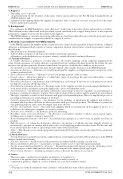Page 514 - Juta's Indirect Tax
P. 514
BGR 006 (2) VALUE-ADDED TAX ACT: BinDing gEnErAL rULingS BGR 006 (2)
1. Purpose
This ruling serves to provide –
• a legal framework for the treatment of discounts, rebates and incentives in the Fast Moving Consumable Goods
(FMCG) industry, and
• guidelines in determining whether the supplier is required to issue a credit note or receive a tax invoice for discounts,
rebates and incentives granted.
2. Background
It is common in the FMCG industry to grant allowances* in the form of discounts, rebates and incentives to retailers. These allowances may either result in the previously agreed consideration for a supply being altered, or may represent payment for a supply of services by the retailer to the supplier.
The FMCG industry is currently experiencing dif culties in classifying which allowances alter the previously agreed consideration for a supply or represent payment for a supply of services.
3. Allowances provided in the FMCG industry
In the FMCG industry, the supplier and the retailer enter into a terms of trade agreement in terms of which a combined allowance is determined which consists of various components. General characteristics of such an agreement consist of the following:
• The allowances are determined upfront.
• A list of all the categories of allowances provided is stated in the agreement.
Allowances can be divided into two categories, namely, variable allowances and xed allowances.
3.1 Variable allowances
A variable allowance is granted to a retailer subject to the retailer satisfying certain conditions stipulated in the terms of trade agreement. A variable allowance is granted based on conditions that must be met by the retailer. In some instances, the supplier grants the allowance immediately, irrespective of whether the conditions are met or not.
Set out below is a non-exhaustive list and a brief description of the variable allowances in the FMCG industry:
• Guaranteed allowances – Allowances received from and paid by suppliers on all purchases/sales, irrespective of the
volumes purchased/sold.
• Early settlement allowances – Allowances received for prompt payment of due accounts.
• Growth rebates – Allowances linked to a volume/value target. A percentage discount is provided when a certain
growth percentage has been achieved.
• Advertising allowances – An allowance that is determined as a percentage of turnover for each purchase/sale and is
not linked to a speci c advertising service.
• Distribution/warehousing allowances – Payments made by the supplier in return for warehousing/redistribution of
stock by the retailer and thereby saving the supplier the costs to store/distribute stock.
• Swell allowances – An allowance provided, calculated as a percentage of turnover, regardless of actual damages or
breakages occurring in relation to products. No records are kept of these products and the products are not returned. The types of products to which a swell allowance will apply are determined upfront. This is to simplify the process of providing an allowance for actual damages or breakage.
• Category management allowances – An allowance for the exchange of information by suppliers and retailers to determine which products sell faster in order to prioritise shelf space for such products. The allowance is granted for data gathering purposes and to make the supply chain more effective.
• Incentive discount/trade rebates – Discounts from suppliers which are all deducted off the supplier’s invoice as a reduction to the selling price (supplier) or cost price (retailer).
• Franchise store allowances – An allowance given for advertising.
• Broadbase range scorecard allowance – An allowance to incentivise retailers to deliver on pre-agreed targets,
including areas of support, ef ciency and growth.
• House/brand/quality assurance allowance – An allowance that quali es as a cost recovery for quality tests done on
products.
• Bulk allowances – A volume-based ef ciency allowance, also known as a bulk-buy discount, whereby retailers are
incentivised to purchase in a manner which reduces the cost of supplying products into their stores. The discount will
be an amount per baler or unit or a percentage of the value of those purchases.
• Tallies – This allowance is an amount per product purchased/sold. It is product-speci c and agreed for goods near its
sell-by date.
3.2 Fixed allowances
A xed allowance is granted based on the condition that an actual supply is performed. Fixed allowances in the FMCG industry include the following:
• New store allowance – An allowance for the promotion of products with the opening of a new store.
• Major refurbishment allowance – A payment to revamp a retailer’s store to meet the required standards.
• Speci c promotional/Gondola/Ad hoc allowance – Payment for promotional support or speci c advertising service
with the purpose to drive additional sales that does not form part of the annual agreed support grid. • Post-recession allowance – Assistance provided to stores to decrease the effects of a recession.
4. Issues
The issues under consideration are whether an allowance is regarded as a –
• reduction of the purchase price in which case a credit note must be issued; or
• consideration paid for a supply of a service in which case a tax invoice must be issued.
* For purposes of this document, the term ‘allowance’ will include discounts, rebates and incentives.
506 Juta’s IndIrect tax 2016


